无氟制冷剂HCR22热管低温储粮温度动态特征
2022-02-06刘金光刘玉茜王世清蔺新茹曲亚男姜文利
刘金光,刘玉茜,王世清,蔺新茹,曲亚男,姜文利
无氟制冷剂HCR22热管低温储粮温度动态特征
刘金光1,2,刘玉茜3,王世清1,2※,蔺新茹3,曲亚男3,姜文利1,2
(1. 青岛农业大学食品科学与工程学院,青岛 266109;2. 青岛市现代农业质量与安全工程重点实验室,青岛 266109;3. 山东农业大学食品科学与工程学院,泰安 271018)
为解决机械制冷低温储粮存在的高能耗、环境不友好等问题,该研究基于低温热管储粮和无氟制冷剂HCR22蓄冷方面的研究,设计并开发了使用自然冷源蓄冷的低温试验粮仓,其结构包括热管组、温度检测系统和结露控制系统等,热管工质选用新型无氟制冷剂HCR22。为研究低温试验粮仓的蓄冷性能,对HCR22热管仓房储粮过程热管组和储粮温度的动态特征规律进行研究。结果表明:HCR22热管仓房365 d储粮期间小麦温度持续低于16 ℃,最低可降至-3.10 ℃,仓内不同位置降温均匀、平缓,实现了小麦的低温或准低温储藏;储藏期间小麦含水量下降0.29%,籽粒浸出液电导率值提升4.20S/cm。该研究为中高纬度地区提供一种无能耗、环境友好型储粮新方式,为绿色储粮技术升级提供科学依据。
温度;粮食;储藏;无氟制冷剂;低温热管;自然冷源
0 引 言
温度是影响粮食贮存品质的重要因素。低温储粮技术即维持仓内粮食平均温度持续低于15 ℃,局部温度不高于20 ℃,通过低温抑制储粮害虫繁殖和微生物生长,减缓籽粒呼吸作用,进而维持储粮生态系统稳定,延长贮存期[1-2]。Mylona等[3]发现小麦和玉米低于15 ℃贮存,可以降低感染脱氧雪腐镰刀菌烯醇和伏马菌素的风险。Liu等[4-7]报道高温是诱导稻谷储藏品质劣变(黄变)的重要因素,劣变期间粮谷内部过氧化物酶、过氧化氢异构酶等抗氧化酶含量提升,黄酮类代谢产物富集,支链氨基酸、脯氨酸浓度增大。现阶段,中国国储粮库和大型商业粮仓常用的低温储粮技术是机械通风和机械制冷结合的方式[8]。科研人员研究发现准低温储藏既可以保持储粮品质,也能够降低低温储粮设备的能耗[9-11]。准低温储粮是指365 d储藏期间粮食平均温度不超过20 ℃,局部位置温度不超过25 ℃[12]。
相比机械制冷储粮的巨大能耗,自然冷源蓄冷储粮具有微能耗或无能耗、绿色清洁的优势。受地球公转影响,中高纬度地区冬季拥有丰富的自然冷源,包括风冷、冰、雪等,但受蓄冷技术不足的影响,自然冷源有效利用率较低。近年来,相关学者尝试利用自然冷源蓄冷技术进行储粮[13]。Jing等[14-15]设计并制作了太阳能吸附制冷装置,利用太阳能提供动力实现了低温储粮,但冷量仓内扩散需要风机,且循环水源设置于仓顶存在泄漏隐患。Kumar等[16]开发的雪冷系统降低了制冷装置的能源消耗和温室气体排放,但对于降雪较少的地区实用性较小,且雪储存仓密闭性和保温性能建造标准较高。Luo等[17]发现太阳能吸附制冷机夏季储粮可以保持仓内上层粮食温度低于20 ℃,但室外温度未达到系统运行的光照温度(29~34 ℃)前,仓内环境温度已高于粮食储藏的适宜温度。本团队基于自主开发的自然冷源蓄冷技术,设计并制作了微型热管低温储粮仓,用氟利昂R22为热管循环工质,借助热管将自然冷能蓄积到粮仓降温并抑制虫害发生,但氟利昂的使用存在破坏臭氧层的不足[9,18-19]。
新型碳氢制冷剂(HCR134a、R600a和R290等)作为传统氟利昂的替代制冷剂,具有环境友好型、高效节能等优势。新型碳氢制冷剂仅由C、H元素构成,消耗臭氧潜能值(Ozone Depletion Potential,ODP)为0,全球变暖潜能值(Global Warming Potential,GWP)<1[20-21]。HCR22是替代氟利昂R22的新型碳氢制冷剂,是丙烷和丁烷的混合烷烃。本团队前期研究发现,低温热管可以使用HCR22替换R22进行单向导热蓄冷,且HCR22充注量仅为R22的1/3[20]。
基于前期研究基础,本研究使用冬季环境的寒冷空气作为自然冷源,设计并制作了无能耗、环境友好型的自然冷源蓄冷低温试验粮仓,使用无氟制冷剂HCR22作为热管循环工质,结合重力热管单向导热的特点将自然冷源积贮到粮仓并维持全年准低温。对比R22制冷剂,测试HCR22用于粮仓热管的蓄冷效果,实时记录365 d储粮周期内热管蓄冷能力和粮仓不同位置温度变化,以期为中高温纬度地区利用新型碳氢制冷剂HCR22实现无能耗、环境友好型的准低温储粮提供科学依据。
1 环境友好型粮仓设计及储粮测试
1.1 环境友好型粮仓设计
环境友好型粮仓结构主要包括粮谷仓房、热管组、实时温度检测装置、结露控制系统和压力检测器等,如图1所示。
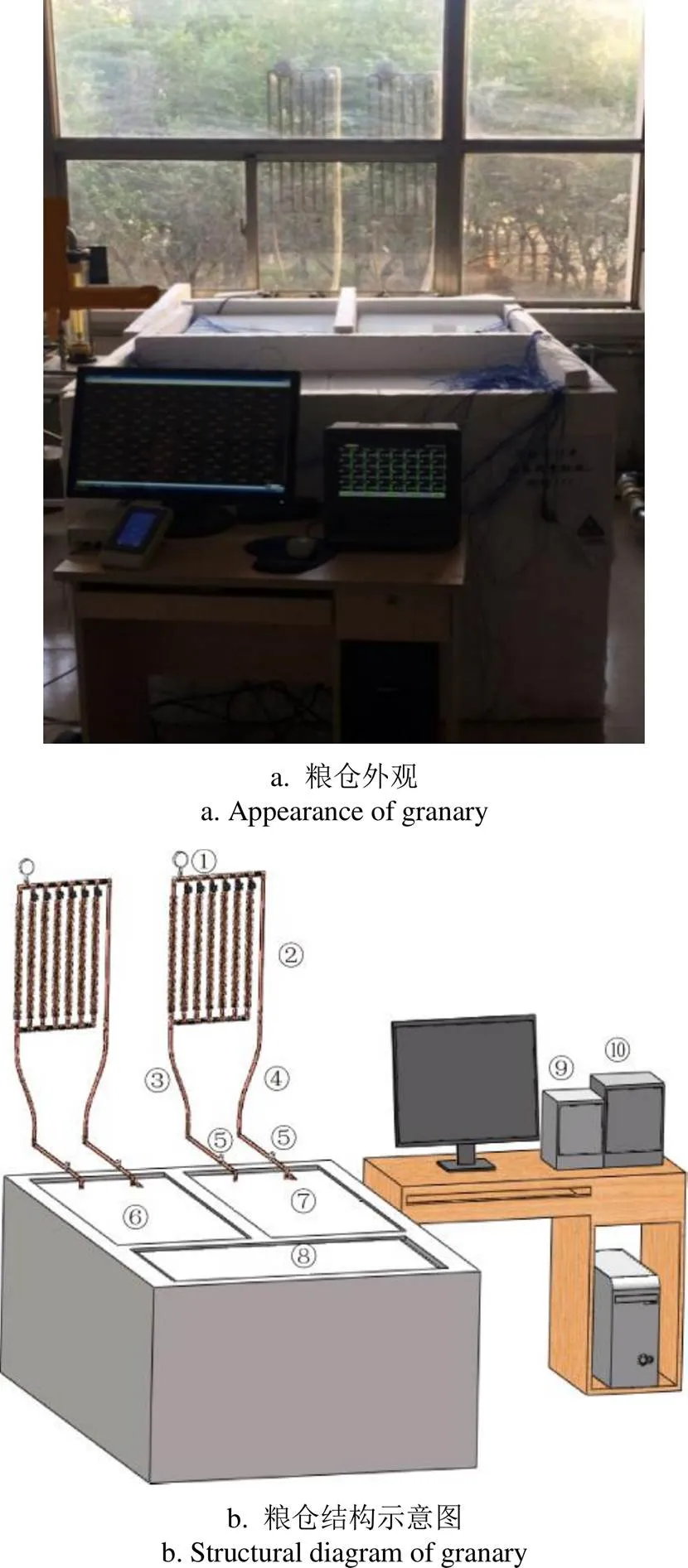
①压力检测器②热管冷凝段③冷凝液下降通道④蒸汽上升通道⑤电磁阀⑥HCR22热管仓房⑦R22热管仓房⑧无热管仓房⑨结露控制系统⑩实时温度检测系统
1.1.1 粮谷仓房
为了对比低温热管仓房与无热管仓房、热管仓房使用HCR22制冷剂与R22制冷剂的蓄冷效果,在山东省青岛市建造了尺寸完全相同的3个小仓房(试验粮仓),如图1b所示,标记⑥为HCR22热管仓房、⑦为R22热管仓房和⑧为无热管仓房,其中,⑥和⑦仓房内安装结构相同的热管组。参考《粮食仓库建设标准建标172-2016》和青岛第2粮库高大平房仓尺寸,试验粮仓每个仓房的长×宽×高皆为1 200 mm×800 mm×1 000 mm,仓容为300 L,仓体构造为保温层-钢结构-保温层。
1.1.2 低温热管组循环系统
热管被誉为热的“超导体”,通过充填的循环工质相变完成小温差单向、高效传热[9,22]。本试验所用热管组的结构设计参考了作者前期工作[20,23]和张岩等[24]设计的小型热管储粮系统。图2为试验粮仓测温点分布图。由图2可知,粮仓结构主要包括蒸发段、冷凝段、连接段和压力检测器等部件。其中,蒸发段、冷凝段和连接段的材质为紫铜,蒸发段整体结构为长方体框架,安装在粮谷仓房内;冷凝段为排管式结构,各连接处使用金属银焊接;此外,为提高其热交换能力,冷凝段排管表面安装紫铜材质翅片,冷凝段固定安装在室外自然冷源环境中。连接段位于蒸发段和冷凝段之间,包括蒸汽上升通道和冷凝液下降通道,蒸发段、连接段和冷凝段接通形成循环系统。为避免热管循环工质蒸汽在连接段与自然冷源热交换形成逆流阻力,进而削弱冷凝段换热效果,在连接段蒸汽上升通道的外壁覆盖保温、防水材料。
本研究所用热管组类型为分离式重力热管。室外环境温度降低到5 ℃以下,热管冷凝段与蒸发段温差达到热管启动温差,蒸发段内部液态制冷剂吸收粮堆热量发生汽化现象,饱和蒸汽携带汽化潜热受微小压差影响上升到冷凝段,与自然冷源进行热交换释放携带的潜热,同时液化为液态制冷剂,在重力影响下自发汇集于蒸发段,完成一次热管工质循环[9,18]。热管组内制冷剂持续吸热蒸发、冷凝放热的工质循环过程,热量从高温段传递至低温段,粮堆热量导出、自然环境冷量导入,实现粮谷仓房自然冷源积聚,整个循环过程无需任何能耗。
1.1.3 实时温度检测装置
本研究中各处布温点实时温度检测使用T型热电偶,布点方法参考文献[25]。如图2所示,HCR22热管仓房分布1~19号测温点,测定储粮过程中HCR22热管仓房温度变化;R22热管仓房对照位置布20~38号测温点,测定R22热管仓房温度变化;无热管仓房对照位置布41~57号测温点,测定无热管仓房温度变化。39号、40号测温点分别设置在HCR22仓房冷凝段和R22仓房冷凝段的周边位置,测定储粮过程中粮仓周边温度变化。58号测温点设置在仓房周围室内环境中,测定室内环境的温度;59号测温点设置在室外环境中,测定自然冷源的温度。多路温度记录仪(TP1000-64,TOPRIE)及配套软件Temp Curve进行储藏过程中温度测点数据的采集和记录,数值精度±0.2℃,采集间隔4 s/次。
1.1.4 结露控制系统
自然冷源温度变化受到大气寒流和光照强度等多因素干预,存在较大的昼夜温差值,导致靠近热管蒸发段的小麦层发生结露问题,参考文献[13,17],将热管组连接段添加结露控制系统,预设8 ℃作为电磁阀的温控设定值。
结露控制系统的工作原理:蒸发段周围小麦均温与外界环境温度的差值低于设定值,电磁阀常开状态,热管组保持工作模式,其他工况时,电磁阀关闭,热管组停止运行。
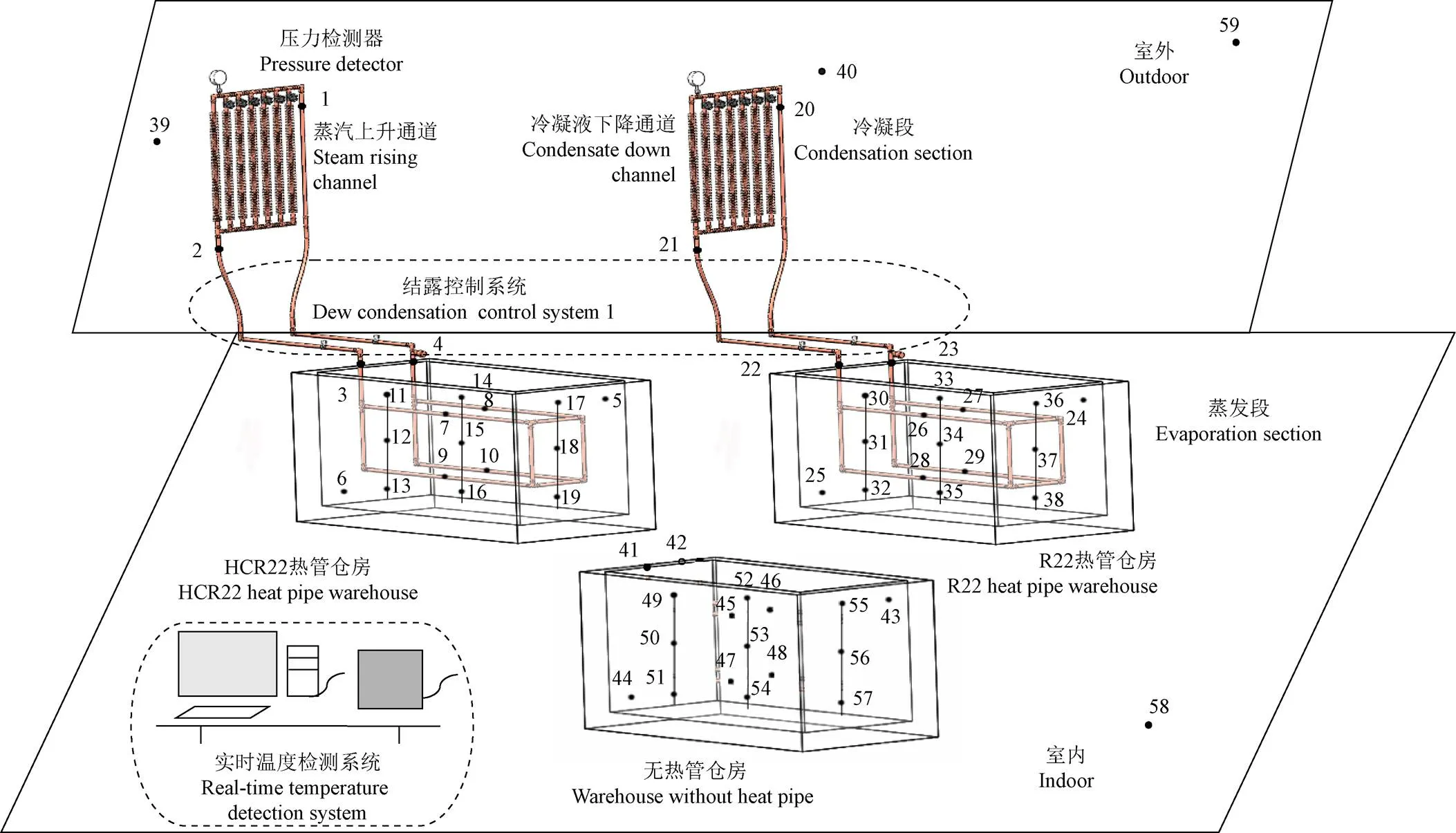
注:1~19为HCR22热管仓房测温点,20~38为R22热管仓房对照位置测温点,41~57为无热管仓房对照位置测温点。39号测温点设置在HCR22仓房冷凝段周边位置,40号测温点设置在R22仓房冷凝段周边位置,测定储粮过程中温度变化。58号测温点设置在仓房周围室内环境中,测定室内环境的温度;59号测温点设置在室外环境中,测定外界自然冷源的温度。
1.2 储粮期间热管性能及小麦品质特性测试
1.2.1 粮仓蓄冷能力试验
HCR22热管仓房内热管组工质使用HCR22冷剂,R22热管仓房中热管组内充注R22冷剂,无热管仓房不充注。热管组工况检测完成后,向3个仓房内装填相同质量小麦。小麦由青岛第二粮库提供,为当年新入仓、广泛种植品种的小麦样品。当室外环境最低温度连续低于5 ℃,即热管组冷凝段与仓内蒸发段周围小麦的温差超过热管启动温差时,热管组内制冷工质启动,HCR22和R22热管仓房执行无能耗蓄冷模式。365 d储粮期间,连续采集并记录各测温点温度数据,分析环境友好型粮仓的蓄冷能力。
1.2.2 小麦品质变化测定
1)小麦籽粒含水量检测参照《GB/T 5497—1985 粮食、油料检测水分测定法》测定[26]。
2)小麦籽粒电导率值检测使用电导率仪(S230-K,Mettler Toledo),取试验样本50粒小麦,平行样本称质量差值≤0.01 g,蒸馏水冲洗后用滤纸去除表面水,在100 mL、20 ℃恒温去离子水中浸泡24 h,分别测出浸出液的电导率值(S/cm)和去离子水的电导率值(S/cm),则籽粒浸出液的电导率值1(S/cm)=-。
2 结果与分析
2.1 测温点温度数据分析
2.1.1 粮仓小麦均温变化规律
图3为试验粮仓小麦温度变化。由图3可知,HCR22热管仓房和R22热管仓房的粮食平均温度持续低于16 ℃,符合《GB/T 29890—2013 粮油储藏技术规范》[12]的准低温储藏。由温度统计曲线可以看出,HCR22热管仓房和R22热管仓房的小麦平均温度波动平缓,大部分时间比对照仓房小麦平均温度值低7 ℃。此外,HCR22热管仓房小麦平均温度比R22热管仓房低0.6 ℃,由此推断,低温热管选用新型无氟制冷剂HCR22作为循环工质利用自然冷源蓄冷储粮的效果较氟利昂制冷剂R22更优。原因是HCR22制冷剂的汽化潜热值(428 kJ/kg)高于R22制冷剂(233 kJ/kg)。
数据统计发现,粮食入仓后,HCR22热管仓房和R22热管仓房内粮食平均温度自11月27日起低于无热管仓房,表明此时热管组启动并执行蓄冷工作。热管仓房粮食平均温度在第54天时下降至0 ℃,HCR22热管仓房粮食在第56天时达到最低温度-3.1 ℃,同样的,R22热管仓房达到最低温度-2.3 ℃,而无热管仓房粮食平均温度为8 ℃。综上所述,热管组运行后,通过工质循环到自然冷源蓄积到仓内。次年3月15日,室外环境平均温度渐渐高于粮食平均温度,此时,热管内部制冷工质循环终止,自此,热管仓房使用蓄冷期间储存的冷量维持仓内小麦准低温环境。
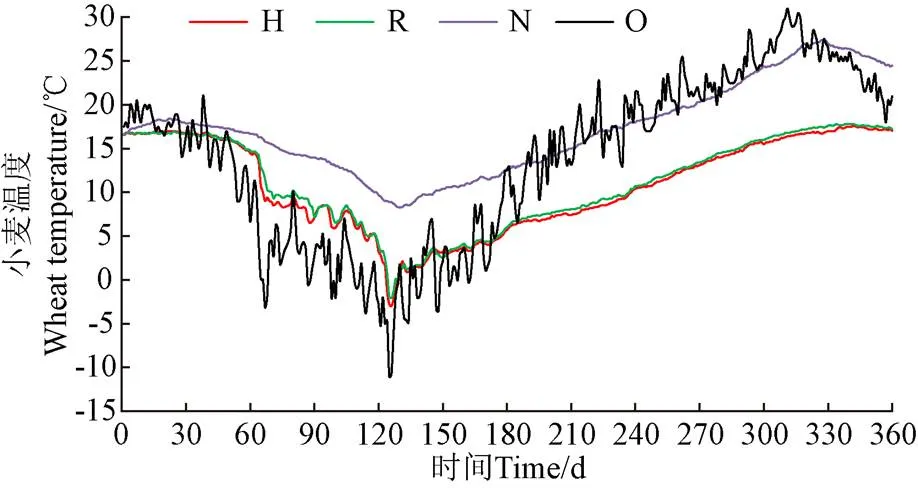
注:统计时间为9月25日至次年9月20日,温度值为当天平均温度,以9月25日为第1天。H,HCR22热管仓房;R,R22热管仓房;N,无热管仓房;O,室外环境;下同。
2.1.2 热管组蒸发段温度变化规律
由图4可以看出,自然环境温度与仓内小麦温度的差值达到热管启动温差后,热管开始蓄冷,期间热管组蒸发段温度值随外界冷源温度变化表现出相对应的波动。热管组蓄冷期间,蒸发段温度低于冷源温度5.0~8.0 ℃,HCR22热管仓房蒸发段温度值低于R22热管仓房蒸发段0.8~1.2 ℃。
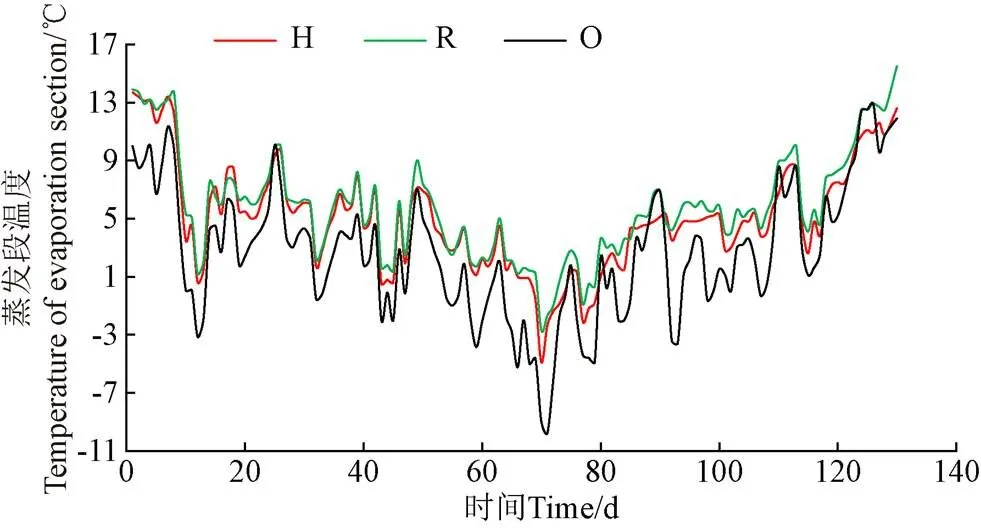
注:统计时间为11月15日至次年3月25日,温度数据为当天平均温度。
自11月25日起,外界冷源温度最低值维持在5 ℃以内,满足工质循环启动要求,热管组启动,蒸发段温度骤降。数据分析显示,热管组启动后蓄冷运行第56天,HCR22热管仓房蒸发段温度值达到最低示数-4.3 ℃,R22热管仓房蒸发段温度显示最低值-3.2 ℃。自第2年3月10日起气温回升,外界冷源的日均温度逐渐高于热管仓房蒸发段周围小麦平均温度值,热管组终止工作。据统计,HCR22热管仓房热管组工作时间是11月25日起至第2年3月10日,共计蓄冷108 d。
2.1.3 HCR22仓粮堆内部温度变化规律
图5 为HCR22热管仓房中粮堆内部温度变化,研究发现HCR22热管仓房热管组工作期间,冷量由小麦粮堆内部向外扩散,即低温热管储粮的“冷心”情景。此状态出现的原因是小麦采收后晾干入仓,作为储粮的小麦籽粒仍然保持一定活性,仓内相对密闭的环境下,长期堆积和籽粒呼吸共同导致堆积产热;HCR22热管仓房热管组运行后,外界冷源通过热管组蒸发段进入仓内并不断蓄积,蒸发段周围小麦层最先接触冷源,通过冷能持续集聚并逐渐向外粮层传递,维持整个仓房降温,因此,粮堆内部温度较低。结合图2和图5可知,编号16测温点设置在HCR22热管仓房热管组蒸发段下层的中间位点,蒸发段特殊的结构设计导致此处接受制冷工质蒸发吸热和液化放热后低温制冷工质的作用最大,因此,其温度值最低。编号12测温点设置在HCR22热管仓房热管组蒸发段靠近蒸汽上行通道的位置,此处接受蒸发段内制冷工质蒸发吸热的作用较弱,因此,其温度值最高。编号15测温点设置在HCR22热管仓房热管组蒸发段上、下层的中间位置;因小麦属于非热导体、传热较弱的缘故,因此,其温度值比编号14和编号16测温点更大。除此之外,图中HCR22热管仓房内部不同位置的5个测温点温度值变化规律显示,小麦粮层最高与最低温度值的差值是2.2 ℃,由此推断,现有技术基础上,通过提升热管组蒸发段的有效散热面积可以进一步使仓内储粮小麦各深度粮层平均温度下降,也可以通过增设仓内循环风道提高冷能扩散[14-15]。
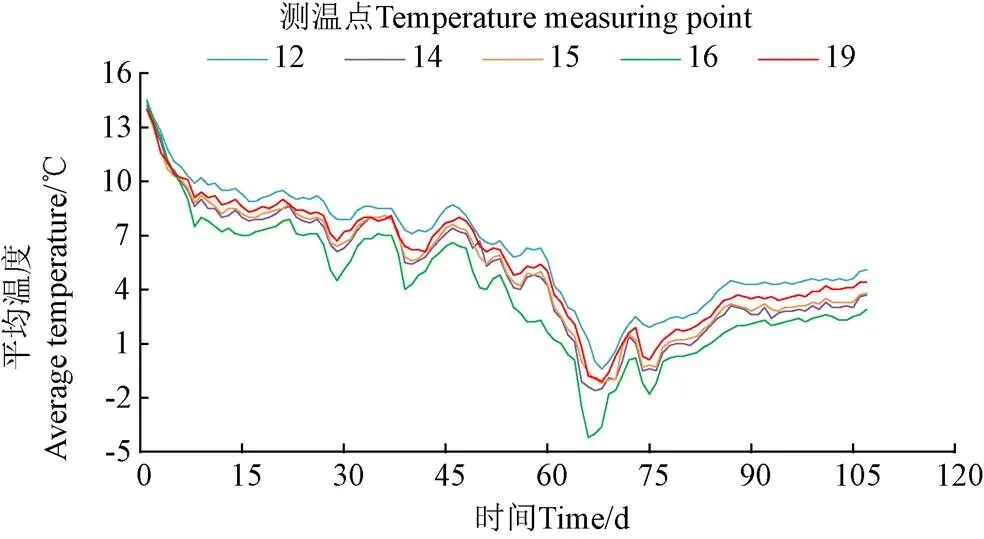
注:统计时间为11月25日至次年3月10日,温度数据为当天平均温度。
2.2 小麦储藏品质变化特征
2.2.1 小麦籽粒含水量变化规律
小麦采收后晾晒至安全入仓含水量,常规仓储期间,仓房通风降温、除湿过程伴随小麦水分含量损失,间接地提高了仓储成本,有效控制储粮失水是仓储环节的重要工作[27]。环境友好型低温试验粮仓利用热管组将外界自然冷源蓄积到粮堆内部,有效避免了通风道周围气流快速流动导致的储粮水分散失。如图6所示,HCR22热管仓房和R22热管仓房储粮小麦含水量下降幅度小于无热管仓房,HCR22热管仓房小麦水分含量下降0.29%,R22热管仓房降低0.30%,无热管仓房下降0.56%,可见,HCR22热管仓房储粮含水量损耗比无热管仓房更低。推断其原因,应是热管仓房较低的空气温度不利于粮层间自由水迁移。
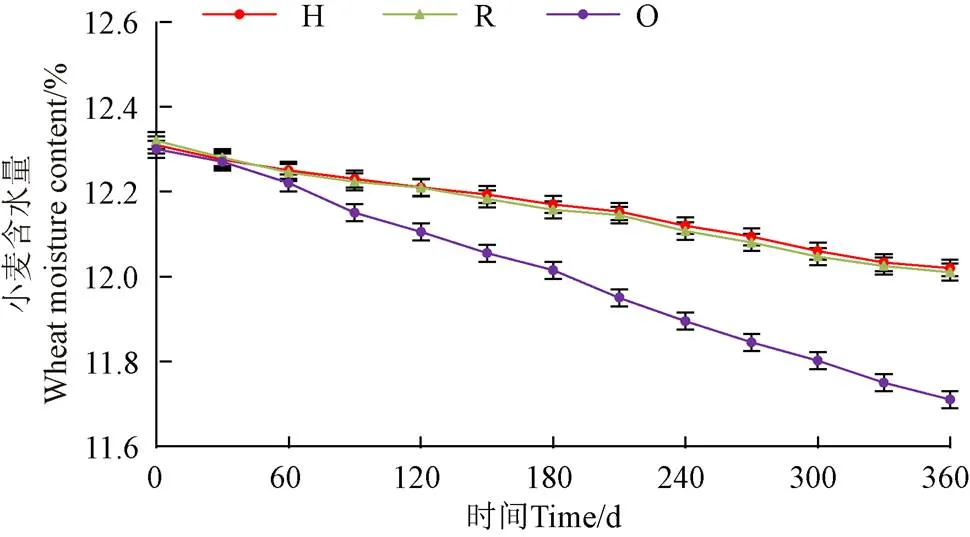
注:统计时间同图3。
2.2.2 小麦籽粒电导率值变化规律
小麦种子浸出液的电导率变化规律可以表征仓储期间膜脂过氧化作用对细胞膜的破坏程度,细胞膜受损程度越大,胞内电解质扩散越快,电导率数值越高[28],如图7所示。
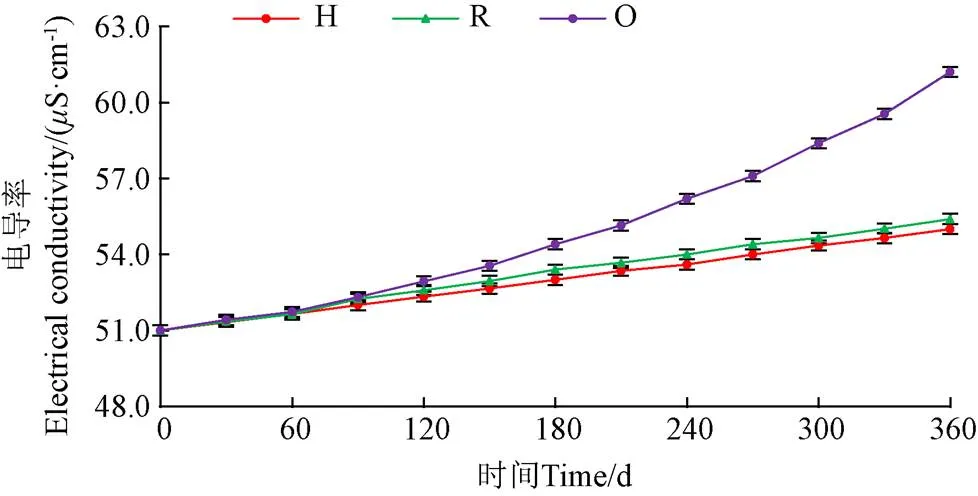
注:统计时间同图3。
由图7可知,HCR22热管仓房小麦种子电导率值提升4.20S/cm,R22热管仓房提升4.40S/cm,无热管仓房提升10.11S/cm,由此推断,HCR22热管仓房可以延缓仓储期间膜脂过氧化作用对细胞膜的损伤。
3 结 论
本文提供了一种绿色储粮技术的环境友好型低温试验粮仓,使用新型环保制冷剂HCR22作为热管工质,热管组工作时间是11月25日至次年3月10日,共计蓄冷108 d,期间仓内各测温点小麦粮层降温平缓,第54天粮食降温至0 ℃,最低温度为-3.1 ℃,365 d储藏周期内小麦温度维持在16 ℃内,实现了低温或准低温储藏。仓内准低温环境减缓了小麦籽粒水分散失,减弱了膜脂过氧化作用对种子细胞膜的破坏程度,储藏期间小麦含水量下降0.29%,籽粒浸出液电导率值提升4.20S/cm。
本研究设计的环境友好型低温试验粮仓,可在标准储粮库高大平房仓的框架结构上进行改装,蒸发段、连接段和冷凝段采用铜制管材,热管组配合仓房通风降温系统使用,节省了制冷设备的购置和使用费用。建议在中高纬度地区冬季寒冷且时间较长地区建造本文设计的环境友好型低温试验粮仓。本文储粮技术的应用有利于促进无能耗、绿色储粮技术升级,对节能减损、提升储粮品质具有重要意义。今后研究重点需开发粮层间冷量辅助扩散装置,提升蓄积冷能及时、均匀扩散,降低粮层间温差。
[1] Jian F J, Jayas D S. The ecosystem approach to grain storage[J]. Agricultural Research, 2012, 1(2): 148-156.
[2] 李倩倩,姜俊伊,毕文雅,等. 不同水分“盐丰47”稻谷低温和准低温储粮品质变化规律研究[J]. 保鲜与加工,2022,22(5):9-16.
Li Qianqian, Jiang Junyi, Bi Wenya, et al. Study on grain quality change law of different water contents‘Yanfeng 47’paddy stored at low temperature and quasi low temperature[J]. Storage and Process, 2022, 22(5): 9-16. (in Chinese with English abstract)
[3] Mylona K, Sulyok M, Magan N. Relationship between environmental factors, dry matter loss and mycotoxin levels in stored wheat and maize infected with Fusarium species[J]. Food Additives and Contaminants, 2012, 29(7): 1118-1128.
[4] Liu Y, Shad Z M, Strappe P, et al. Review on rice yellowing: Physicochemical properties, affecting factors, and mechanism[J]. Food Chemistry, 2022, 370, 131265.
[5] Liu Y, Liu J, Liu M, et al. Comparative non-targeted metabolomic analysis reveals insights into the mechanism of rice yellowing[J]. Food Chemistry, 2020, 308, 125621.
[6] Liu Y, Liu J, Wang R, et al. Analysis of secondary metabolites induced by yellowing process for understanding rice yellowing mechanism[J]. Food Chemistry, 2021, 342: 128204.
[7] Liu Y, Liu J, Wang A, et al. Physiological and proteomic analyses provide insights into the rice yellowing[J]. Journal of Cereal Science, 2020, 95: 103048.
[8] Liu Y, Ma J. Analysis of refrigeration system for quasi-low temperature warehouse[J]. Procedia Environmental Sciences, 2012, 12(Part A): 354-359.
[9] 李新宇,熊旭波,张岩,等. 热管低温储粮技术对小麦品质的影响[J]. 中国粮油学报,2015,30(1):107-111.
Li Xinyu, Xiong Xubo, Zhang Yan, et al. Effect of heat pipe based low-temperature grain storage technology on wheat quality[J]. Journal of Chinese Cereals and Oils Association, 2015, 30(1): 107-111. (in Chinese with English abstract)
[10] 李文泉,付鹏程,高玉升,等. 华北地区浅圆仓大豆准低温储藏工艺研究粮食储藏[J]. 粮食储藏,2020,49(5):1-5.
Li Wenquan, Fu Pengcheng, Gao Yusheng, et al. Study on quasi-low temperature storage technology for soybean in squat silos in north China[J]. Grain Storage, 2020, 49(5): 1-5. (in Chinese with English abstract)
[11] 李卓珍,渠琛玲,王红亮,等. 优质稻谷准低温储藏与常温储藏品质变化的比较研究[J]. 中国粮油学报,2020,35(11):104-110.
Li Zhuozhen, Qu Chenling, Wang Hongliang, et al. Comparative study on the quality changes of the high quality paddy during quasi-low temperature storage and conventional temperature storage[J]. Journal of Chinese Cereals and Oils Association, 2020, 35(11): 104-110. (in Chinese with English abstract)
[12] 中国国家标准化管理委员会. GB/T 29890-2013 粮油储藏技术规范[S]. 北京:中国标准出版社,2013.
[13] 刘金光,熊旭波,王世清,等. 自然冷源蓄冷低温热管储粮中防止结露的方法研究[J]. 粮油食品科技,2017,25(7):74-79.
Liu Jinguang, Xiong Xubo, Wang Shiqing, et al. Study on preventing condensation in low temperature heat pipe for grain storage by natural cold source[J]. Science and Technology of Cereal, Oils and Foods, 2017, 25(7): 74-79. (in Chinese with English abstract)
[14] Jing Y W, Sheng L, Yan F H. Study on cyclic characteristics of the solar-powered adsorption cooling system[J]. Science China Technological Sciences, 2009, 52(6): 1551-1562.
[15] Luo H L, Wang R Z, Dai Y J. An efficient solar-powered adsorption chiller and its application in low-temperature grain storage[J]. Solar Energy, 2007, 81(5): 607-613.
[16] Kumar V, Hewage K, Haider H, et al. Sustainability evaluation framework for building cooling systems: A comparative study of snow storage and conventional chiller systems[J]. Clean Technologies and Environmental Policy, 2016, 5(10): 1-19.
[17] Luo H L, Wang R Z, Dai Y J, et al. Low-temperature grain storage with a solar-powered adsorption chiller: A case study[J]. International Journal of Green Energy, 2014, 11(1): 50-59.
[18] 修方珑,张岩,王世清,等. 基于热管技术的储粮仓温度特征及其抑虫效果[J]. 农业工程学报,2013,29(14):256-261.
Xiu Fanglong, Zhang Yan, Wang Shiqing, et al. Temperature characteristic and inhibition effect on insect pest in grain storehouse based on heat pipe technology[J]. Transactions of the Chinese Society of Agricultural Engineering (Transactions of the CSAE), 2013, 29(14): 256-261. (in Chinese with English abstract)
[19] 王世清,张岩,姜文利,等. 热管技术在自然冷源蓄冷中的应用[J]. 农业工程学报,2010,26(4):312-316.
Wang Shiqing, Zhang Yan, Jiang Wenli, et al. Application of heat pipe technology in ice storage of natural coldness resource[J]. Transactions of the Chinese Society of Agricultural Engineering (Transactions of the CSAE), 2010, 26(4): 312-316. (in Chinese with English abstract)
[20] 刘金光,熊旭波,王世清,等. 低温热管中无氟制冷剂HCR-22的蓄冷效果[J]. 农业工程学报,2016,32(19):268-273.
Liu Jinguang, Xiong Xubo, Wang Shiqing, et al. Cooling effect of fluorine free refrigerant HCR-22 used in heat pipe[J]. Transactions of the Chinese Society of Agricultural Engineering (Transactions of the CSAE), 2016, 32(19): 268-273. (in Chinese with English abstract)
[21] Ho-Saeng L, Chang-Hyo S. Condensation heat transfer and pressure drop characteristics of R-290, R-600a, R-134a and R-22 in horizontal tubes[J]. Heat Mass Transfer, 2010, 46(5): 571-584.
[22] Chan C W, Siqueiros E, Ling-Chin J, et al. Heat utilisation technologies: A critical review of heat pipes[J]. Renewable & Sustainable Energy Reviews, 2015, 50: 617-625.
[23] 刘金光,刘文瑶,王世清,等. 可拆转PE-RT低温热管蓄冷装置及其使用碳氢制冷剂的蓄冷效果[J]. 食品与机械,2018,34(10):81-85.
Liu Jinguang, Liu Wenyao, Wang Shiqing, et al. Removable cold storage device with PE-RT low temperature heat pipe and its cold storage effect using hydrocarbon refrigerants[J]. Food & Machinery, 2018, 34(10): 81-85. (in Chinese with English abstract)
[24] 张岩,姜文利,邵焕霞,等. 小型热管低温储粮的应用试验[J]. 中国粮油学报,2014,29(9):79-81,86.
Zhang Yan, Jiang Wenli, Shao Huanxia, et al. Application test on low temperature grain storage with small heat pipe system[J]. Journal of the Chinese Cereals and Oils Association, 2014, 29(9): 79-81, 86. (in Chinese with English abstract)
[25] Zhangab X, Shena J, Heac W, et al. Comparative study of a novel liquid-vapour separator incorporated gravitational loop heat pipe against the conventional gravitational straight and loop heat pipes - Part II: Experimental testing and simulation model validation[J]. Energy Conversion and Management, 2015, 93: 228-238.
[26] 国家标准局. GB/T 5497-1985 粮食、油料检测水分测定法[S]. 1985.
[27] Khatchatourian O A, Oliveira F A. Mathematical modelling of airflow and thermal state in large aerated grain storage[J]. Biosystems Engineering, 2006, 95(2): 159-169.
[28] 周显青,祝方清,张玉荣,等. 不同储藏年限稻谷的储藏特性、生理生化指标及其糊化特性分析[J]. 中国粮油学报,2020,35(12):108-114,124.
Zhou Xianqing, Zhu Fangqing, Zhang Yurong, et al. Analysis of the storage property, physiological, biochemical indicators parameters and the pasting characteristics of rice in different storage time[J]. Journal of Chinese Cereals and Oils Association, 2020, 35(12): 108-114, 124. (in Chinese with English abstract)
Temperature dynamics of the heat-pipe low-temperature grain storage with fluorine-free refrigerant HCR22
Liu Jinguang1,2, Liu Yuqian3, Wang Shiqing1,2※, Lin Xinru3, Qu Yanan3, Jiang Wenli1,2
(1.,,266109,; 2.,266109,; 3.,,271018,)
Storage quality has posed a great influence on the grain security in recent years. It is of great social significance to improve the management level of warehousing for the high quality of stored grain. Traditional grain storage cannot fully meet large-scale production, due to the high energy consumption and environmental problems. It is necessary to develop the green technology of low-temperature grain storage by mechanical refrigeration. In this study, an environment-friendly low-temperature granary was designed using the natural coldness resource. The cold storage was used as the heat pipe with the fluorine-free refrigerant HCR22. The heat-pipe low-temperature grain storage was mainly composed of the grain warehouse, heat pipe group, real-time temperature detection system, dewing control system, and pressure detector. The new fluorine-free hydrocarbon refrigerant HCR22 was selected as the circulating medium of the heat pipe group, rather than the traditional Freon refrigerant R22. A test granary was installed to verify the practical feasibility of the low-temperature heat-pipe system. The test position was selected in the middle and high latitudes with a temperate monsoon climate, located in the Chengyang District, Qingdao, Shandong Province, China (120°12′ E, 36°20′ N). The dynamic parameters of grain temperature were measured in the different positions at the evaporation section of the HCR22 and R22 heat-pipe warehouse using a multi-channel temperature recorder during 365-day grain storage. The warehouse without a heat pipe was set as the control group. An electrical conductivity meter was also utilized to detect the moisture content of wheat and the conductivity of grain leaching solution. The results showed that the HCR22 refrigerant performed the lower temperature grain storage with the natural cold source in the heat-pipe cold storage, compared with the Freon refrigerant R22. The running time of the HCR22 heat-pipe warehouse was from November 25 to March 10 of the next year (a total of 108 days of cold storage). The cyclic process of the heat-pipe cold storage was characterized by the steam rising and the condensate dropping. The external and natural cold source was then accumulated gradually into the grain pile, indicating the “cold core” phenomenon. The accumulated cold energy was diffused finally into each grain layer. The lowest and average temperatures of wheat were achieved at -3.10 ℃ and lower than 16 ℃, respectively, after the 365-day grain storage in the HCR22 heat-pipe warehouse. There was an even and gentle drop of temperature in the different positions inside the granary, indicating the low or quasi-low temperature storage. There was lower water loss of wheat grains and lower damage of membrane lipid peroxidation on the seed cell membrane under the quasi-low temperature environment in the HCR22 heat-pipe warehouse. Specifically, the moisture content of wheat decreased by 0.29%, whereas, the conductivity of grain leaching solution increased by 4.20S/cm during storage. The energy-free and environmentally friendly grain storage can be expected for the middle and high latitudes. The finding can provide a scientific basis to upgrade technology in green grain storage.
temperature; grain; storage;fluorine-free refrigerant; low-temperature heat pipe; nature coldness resource
10.11975/j.issn.1002-6819.2022.20.032
TS210.1
A
1002-6819(2022)-20-0286-07
刘金光,刘玉茜,王世清,等. 无氟制冷剂HCR22热管低温储粮温度动态特征[J]. 农业工程学报,2022,38(20):286-292.doi:10.11975/j.issn.1002-6819.2022.20.032 http://www.tcsae.org
Liu Jinguang, Liu Yuqian, Wang Shiqing, et al. Temperature dynamics of the heat-pipe low-temperature grain storage with fluorine-free refrigerant HCR22[J]. Transactions of the Chinese Society of Agricultural Engineering (Transactions of the CSAE), 2022, 38(20): 286-292. (in Chinese with English abstract) doi:10.11975/j.issn.1002-6819.2022.20.032 http://www.tcsae.org
2022-08-23
2022-09-30
国家自然科学基金项目(32102049,31271963)
刘金光,博士,实验师,研究方向为食品安全保藏与工程。Email: jgliu1024@163.com
王世清,博士,教授,研究方向农产品安全储藏及工程。Email: wangshiqing@126.com
